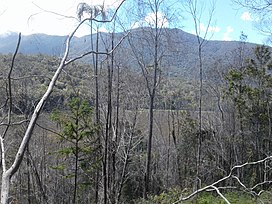| Cyclops Mountains | |
|---|---|
| Pegunungan Cyclops, Pegunungan Dafonsoro, Pegunungan Dobonsolo | |
 | |
| Highest point | |
| Elevation | 2,160 m (7,090 ft) |
| Geography | |
| Location | Papua, Western New Guinea, Indonesia |
The Cyclops Mountains (Indonesian: Pegunungan Cycloop) are located to the west of Jayapura and north of Lake Sentani, in Papua, Indonesia. In Indonesian, the range is also known as Dafonsoro or in Sentani language, Dobonsolo.
The nearby football club Persidafon Dafonsoro is named after the area.
Geography[edit]
The highest point is Ifar Gunung at 2,160 m (7,090 ft)[1] or 2,158 m (7,080 ft).[2]
History[edit]

Parts of the range have long been considered sacred by local Papuan people.[3]
The Cyclops Mountains were given this name by Louis de Bougainville, who saw them from a distance while sailing along the north coast of New Guinea.
In the 1930s Evelyn Cheesman spent time in this area studying the insect fauna.[4] In 1978, and reaffirmed in 1995, the Cyclops Mountains were designated as a nature reserve.[5][6] A University of Oxford-led biodiversity assessment expedition concluded in 2023, finding a number of species new to science.[3]
Ecology[edit]
The portions of the range above 1,000 meters are part of the Northern New Guinea montane rain forests ecoregion. The lower slopes and surrounding lowlands are in the Northern New Guinea lowland rain and freshwater swamp forests ecoregion.
The mountains are rich in biodiversity, with many endemic species found there. Many remain undescribed by scientists due to the mountains' remoteness and impassable terrain.[7] The Cyclops long-beaked echidna (Zaglossus attenboroughi) is unique to the mountains. It is named after naturalist David Attenborough.[8] A unique cave system first described in 2023 by a multinational team led by University of Oxford found a number of endemic species.[3] The mountains are also home to a tree-dwelling shrimp, which has adapted to exist outside of water due to the consistently high humidity, as well as Mayr's honeyeater, which was thought extinct since 2008.[3][7]
| Cyclops Mountains Nature Reserve | |
|---|---|
| Pegunungan Cyclops Nature Reserve | |
| Location | Papua, Western New Guinea |
| Nearest city | Jayapura |
| Area | 225 km2 (87 sq mi) |
| Established | 1978[5]/1995[6] |
A species of lizard, Emoia cyclops (Cyclops emo skink), is named for the Cyclops Mountains.[9]
References[edit]
- ^ Vaisutis, Justine (2007). Indonesia. Fort Mill, South Carolina: Lonely Planet. p. 835. ISBN 978-1-74104-435-5.
- ^ "Cyclop Mountains". Papua Insects Foundation. Retrieved 9 February 2017.
- ^ a b c d "Found at last: bizarre, egg-laying mammal finally rediscovered after 60 years | University of Oxford". www.ox.ac.uk. 2023-11-10. Retrieved 2024-06-22.
- ^ Tuzin, Donald F. (1997). The Cassowary's Revenge: the life and death of masculinity in a New Guinea society. Chicago: University of Chicago Press. p. 86.
- ^ a b "Pegunungan Cyclops". ProtectedPlanet. 2014–2016. Retrieved 9 February 2017.
- ^ a b "Papua: Cyclops Landscape". LESTARI/USAID. Retrieved 9 February 2017.
- ^ a b "First-ever images prove 'lost echidna' not extinct". 2023-11-10. Retrieved 2024-06-22.
- ^ James, William (9 November 2023). "Long-lost mammal rediscovered in remote Indonesia mountains". Reuters.
- ^ Beolens, Bo; Watkins, Michael; Grayson, Michael (2011). The Eponym Dictionary of Reptiles. Baltimore: Johns Hopkins University Press. xiii + 296 pp. ISBN 978-1-4214-0135-5. ("Cyclops", p. 63).
2°30′59″S 140°34′58″E / 2.51639°S 140.58278°E
